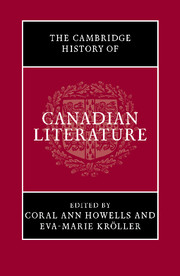Book contents
- Frontmatter
- Introduction
- PART ONE OLD AND NEW WORLD, LA NOUVELLE-FRANCE, THE CANADAS, DOMINION OF CANADA
- PART TWO THE POST-CONFEDERATION PERIOD
- PART THREE MODELS OF MODERNITY, POST-FIRST WORLD WAR
- PART FOUR AESTHETIC EXPERIMENTS, 1960 AND AFTER
- 18 Quartet: Atwood, Gallant, Munro, Shields
- 19 The short story
- 20 Canadian drama: performing communities
- 21 Poetry
- 22 Poetry, drama, and the postmodern novel
- 23 Comic art and bande dessinée: from the funnies to graphic novels
- 24 “Ghost stories”: fictions of history and myth
- 25 Indigenous writing: poetry and prose
- 26 Contemporary Aboriginal theater
- 27 Transcultural life-writing
- 28 Multiculturalism and globalization
- PART FIVE WRITING IN FRENCH
- Bibliography
- Index
- References
26 - Contemporary Aboriginal theater
from PART FOUR - AESTHETIC EXPERIMENTS, 1960 AND AFTER
Published online by Cambridge University Press: 28 September 2010
- Frontmatter
- Introduction
- PART ONE OLD AND NEW WORLD, LA NOUVELLE-FRANCE, THE CANADAS, DOMINION OF CANADA
- PART TWO THE POST-CONFEDERATION PERIOD
- PART THREE MODELS OF MODERNITY, POST-FIRST WORLD WAR
- PART FOUR AESTHETIC EXPERIMENTS, 1960 AND AFTER
- 18 Quartet: Atwood, Gallant, Munro, Shields
- 19 The short story
- 20 Canadian drama: performing communities
- 21 Poetry
- 22 Poetry, drama, and the postmodern novel
- 23 Comic art and bande dessinée: from the funnies to graphic novels
- 24 “Ghost stories”: fictions of history and myth
- 25 Indigenous writing: poetry and prose
- 26 Contemporary Aboriginal theater
- 27 Transcultural life-writing
- 28 Multiculturalism and globalization
- PART FIVE WRITING IN FRENCH
- Bibliography
- Index
- References
Summary
Indigenous theater in Canada, like its artistic counterparts in Australia and Aotearoa/New Zealand, has become a significant force in the nation’s cultural repertoire over the past twenty-five years, capturing the attention of both local audiences and the international performing arts market, notably at major festivals. Not only has there been a rapid expansion in the number and variety of performance works created by Canada’s First Peoples since the mid-1980s but also a concerted attempt to develop industry structures – publicity networks, production companies, training schools, and research laboratories – that will ensure the continued visibility of Indigenous artists in theater across the nation. This cultural project has been an important part of the broader campaign by Aboriginal Canadians to address the multiple effects of European colonization and thereby reclaim forms of agency. The power of performance to expose and reconfigure social relations has been evident on several fronts, not least of which is the contested terrain of representation itself. As practitioners and scholars have observed, Aboriginal theater-makers necessarily contend – in a very visceral and visual way – with the particular burden of stereotyped Indigeneity that has accumulated over centuries through images of “Indianness” circulated in a wide range of pedagogical and imaginative texts. In this context, one of the key achievements of this theater has been to stage the mechanisms by which Indigeneity is constructed, envisaging, in the process, more flexible and varied representations of Aboriginal cultures and practices.
- Type
- Chapter
- Information
- The Cambridge History of Canadian Literature , pp. 518 - 535Publisher: Cambridge University PressPrint publication year: 2009



